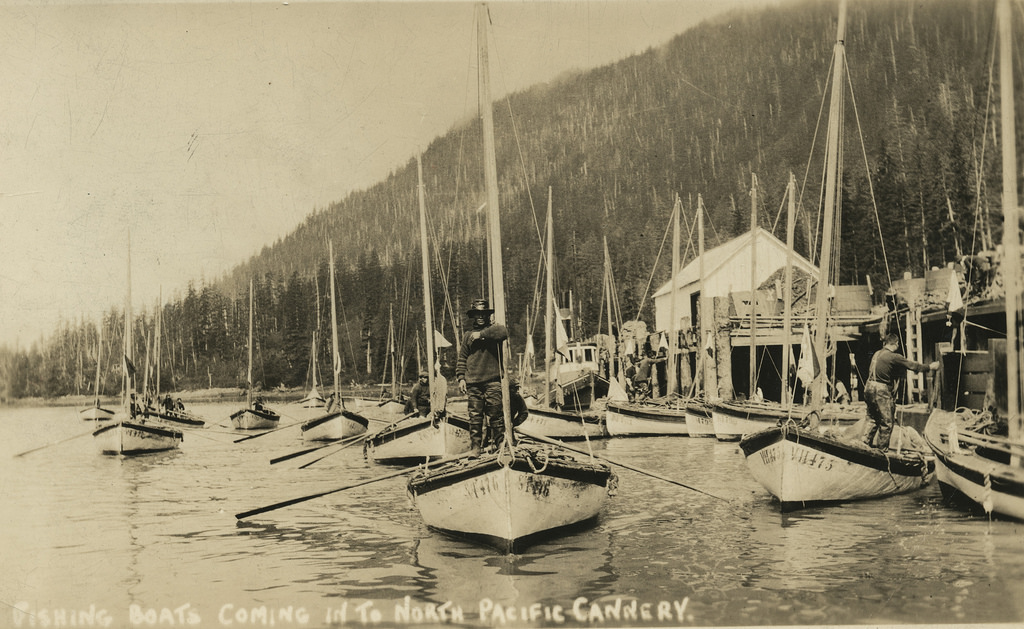At the North Pacific Cannery, Japanese labourers performed a number of duties that are listed as general labourers, boat carpenters, and fishermen for the cannery. The question of Japanese labour restriction to specific jobs leads to the assumption that the Japanese men who were hired for cannery labour only performed cannery duties, and the Japanese men who were hired for fishing were only fishermen providing fish for the production of the cannery. However, in the years 1919 to 1923, it is evident that of those who worked as general labourers and carpenters in the months of April and May in the cannery, some of those men then transitioned to work as fishermen in the months of June to August. Within the records of Japanese employment, labourers are divided among separate ‘houses’ and men typically stayed associated with that house for their duration of employment and returning employment in following years. Interestingly enough, the men that progress from cannery labour to fishing labour stayed associated with the house that they were originally assigned while performing cannery tasks. In the following paragraphs, each year will be broken down into the different Japanese houses to better assess the degree to which Japanese men took up fishing labour after cannery work declined after the month of May to demonstrate house affiliation with men and the fluidity of their labours. Only the cannery labourers that worked for the full months of April and May will be included in this analysis. Due to the difficulty in deciphering last names and variations across texts, some names have possible alternative ways of spelling in the following charts.
In 1919, there is the Tanaka House, Matsumoto House, and Tanino House. Of the ten men who worked consistently for the cannery in April and May, six of those men became fishermen in June to the end of August. Similarly, of the seven men from the Matsumoto House, three definitively chose to become fishermen. However, some of the fishermen from the Matsumoto House were listed as letters “A-G” without a proper name, implying that of the unnamed men, some could have been the same as was listed in the cannery registry. The Tanino House had two men listed for cannery work with men “A-I” listed as fishermen. It is also possible that fishermen were given a letter to record their fishing success instead of recording their name.
In 1920, there was eight men who worked April to May for the Tanaka House, and two who continued as fishermen. The Matsumoto House had four men, of which none became listed as fishermen. For the Tanino House, one out of two transitioned to fishery work.
In 1921, there became an additional fourth house called the Hayashi House. The Hayashi House consistently housed three men for the cannery season, one of which worked in the Messhouse May to August, and two unidentified fishermen “A and B” who could have been the other two men from the cannery months. One out of three men transitioned from the Tanaka House; three of the six from the Tanino House; and none from the Matsumoto House.
In 1922, the Tanaka House had one of the seven inhabitants become fishermen, while the Hayashi House had two of three cannery labourers take up fishing for the cannery. The Tanino House similarly had two of three men transition to fishing.
In 1923, there lost the distinction between houses in regards to fishing labour and cannery labour for the month of April. As a result, three of the nine men who were working since April progressed to fishing work that summer.
From the years 1919 to 1923, it is evident that Japanese men tended to associate to a specific ‘house’ and stay associated to that house regardless if the type of labour they were performing changed, or if they returned the following year. Of the men who did cannery work and then continued to become fishermen for the North Pacific Cannery, at least six of those men were able to return in the following years and only perform fishermen’s tasks.
As this evidence shows, work for Japanese labourers was not static throughout the summer season to the extent that men were able to transition out of cannery labour to work as fishermen for the cannery. This leads to question if being hired as a general labourer within the cannery led to the possibility of entering into fishermen’s labour; or, that men transitioned from cannery to fishermen’s labour out of economic necessity to achieve financial stability. The latter seems more plausible considering that Japanese men tended to be payed less than regular, “white,” labourers. Furthermore, Japanese labourers kept association with a specific house, even when transitioning between jobs or when returning for work in the summer seasons between 1919 and 1923. More broadly, this shows that there was no strict divide between Japanese men who did cannery labour and those who worked for the cannery as fishermen. Japanese labourers thus demonstrated that Japanese men were willing, or had the incentive, to continue working for the cannery as the labour shifted from a demand in cannery labour to fishing labour, and thus illustrating the fluidity in Japanese work at the North Pacific Cannery.
Table Cannery Fishery work by month and year
Works Cited
“Fishermen’s Book: North Pacific Cannery, 1919,” Ledger, Vol. 88, in MS 2 box, North Pacific Cannery Archives, Port Edward, BC.
“Fishermen’s Book: North Pacific Cannery, 1920,” Ledger, Vol. 89, in MS 2 box, North Pacific Cannery Archives, Port Edward, BC.
“Fishermen’s Book: North Pacific Cannery, 1921,” Ledger, Vol. 90, in MS 2 box, North Pacific Cannery Archives, Port Edward, BC.
“Fishermen’s Book: North Pacific Cannery, 1922,” Ledger, Vol. 91, in MS 2 box, North Pacific Cannery Archives, Port Edward, BC.
“Fishermen’s Book: North Pacific Cannery, 1923,” Ledger, Vol. 92, in MS 2 box, North Pacific Cannery Archives, Port Edward, BC.
“Japanese Labour and Wage Book, 1916-1924,” Ledger, Vol. 57, in MS 2 box, North Pacific Cannery Archives, Port Edward, BC.
